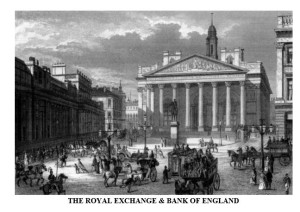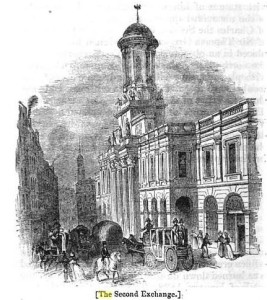 Okay, okay. This bed of commerce wasn’t just hot in the Regency. But, seems someone in a Reg Rom is always talking about the ‘Change…so I figured it was about time to for me to talk about it.
Okay, okay. This bed of commerce wasn’t just hot in the Regency. But, seems someone in a Reg Rom is always talking about the ‘Change…so I figured it was about time to for me to talk about it.
Queen Elizabeth I officially opened the Royal Exchange on January 23, 1571. Until then, the Tudors were transacting business out in the streets in the City of London (still today the financial district of the mega-tropolis.) Royal Agent Sir Thomas Gresham was inspired by his experience in Antwerp, and opened the London Bourse in the late 1560s, moving British business from the streets into one centrally located building whose sole purpose was trading.
After Queen Elizabeth’s stamp of approval and renaming, the Royal Exchange flourished. In addition to trading, it also was a place to buy a wide array of goods on sale, including liquor.
The Great Fire of London (1666) destroyed the original building. It was rebuilt on the original site after three years.
The London Stock Exchange website has a fantastic timeline detailing how in 1698 stock brokers were banned from The Royal Exchange and started to operate out of nearby businesses, most particularly Jonathan’s coffee house (as you may remember from Dickens portrayals).
According to the British Encyclopedia (1809), in 1703 a notice appeared in the paper declaring “all persons are prohibited coming upon the Royal Exchange to do business before the hours of twelve o’clock, and after the hour of two, till evening change.” The time change was signaled by the ringing of a bell. According to Regency era sources, this was necessitated by the increasing presence of stock-jobbers who interrupted the general flow of economic activity occurring at the Royal Exchange.
By 1773, stock brokers had opened up their own building in Sweeting’s Alley, with a dealing room on the ground floor and coffee room above. Briefly known as “New Jonathan’s”, members soon change the name to “The Stock Exchange”. After the official formal membership launch in 1801, the Stock Exchange moved into a new building in 1802 in Capel Court. This was followed quickly by a formalization of rules and regulations.
The fate of the Royal Exchange and later Stock Exchange was inexorably linked to the changing economy. With the original founding of The East India Company in 1600 and its subsequent growth, organizations were increasingly finding that larger sizes (what we now recognize as corporations) protected individuals from loss cycles, shouldered investment costs, and helped to actualize complicated business.
I leave you with a sense of this brave new world from the 1825 Leigh’s new picture of London; or, A view of the … British metropolis:
Interesting footnote, the term bull and bear as applies to markets originated in the 1700s with English trading. Learn more here: http://www.todayifoundout.com/index.php/2013/04/origin-of-the-stock-market-terms-bull-and-bear/









